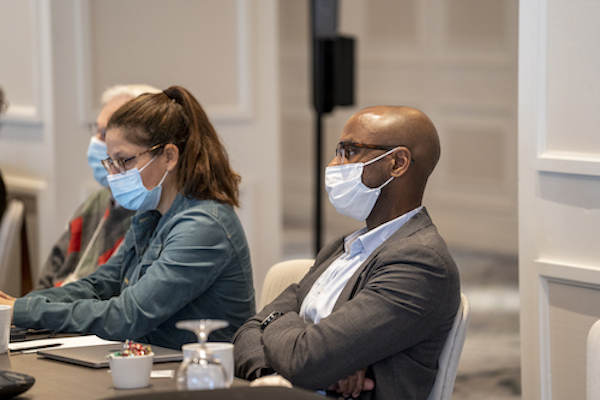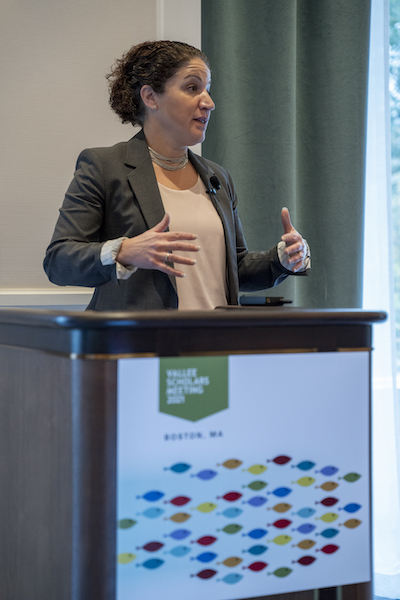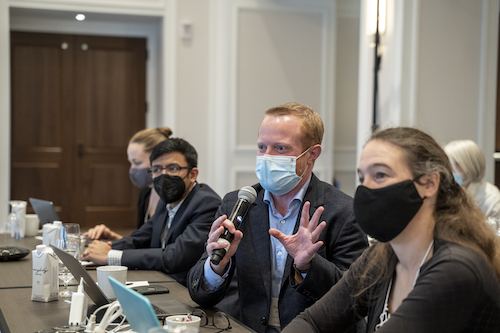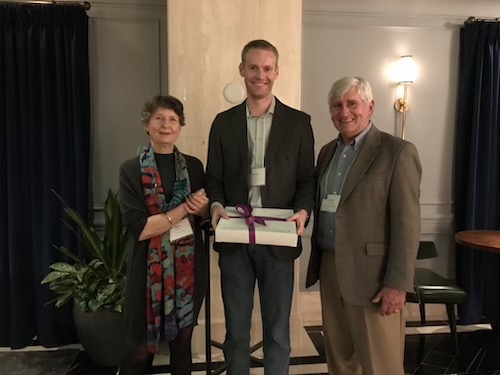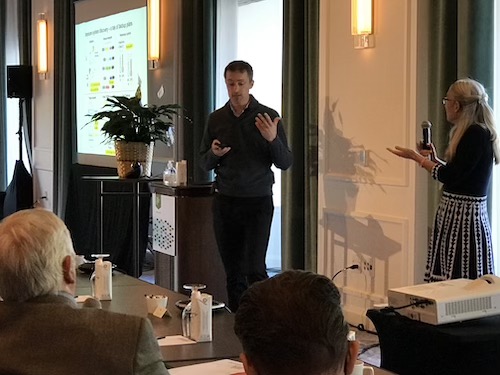Boston
2021 Vallee Scholars Meeting
Three days after the country’s borders re-opened, 43 Vallee Scholars and others connected with the Vallee Foundation met on November 11, 2021, for the biennial Vallee Scholar Meeting at the Newbury Boston. After having to cancel the Vallee Summer Symposium in 2020 it was a real pleasure to gather in person again. For some it was their first in-person meeting since the start of the COVID pandemic, or the first trans-Atlantic trip since the borders had closed. We were all a little nervous at the start but knowing that everyone was triply vaccinated and negatively tested was reassuring. We all wore masks and no-one got sick.
The sessions were ably chaired by three members of the Vallee Scholar Selection Committee: Wade Harper, Committee Chair, Harvard Medical School; Elaine Fuchs, The Rockefeller University; and Eva Nogales, University of California, Berkeley.
The two-day meeting got off to a great start when Nobel Laureate William G Kaelin Jr gave the keynote lecture about his career track from an undergraduate and medical student at Duke to a medical resident at Johns Hopkins to an oncology fellow at the Dana Farber Cancer Institute where he was mentored by David Livingston. He spoke about his research on the von-Hippel-Lindau Hereditary Cancer Syndrome and the importance of being sure biologic questions drive one’s research.
The first Vallee Scholar to speak, Melissa Harrison (VS 2016), Associate Professor at the University of Wisconsin-Madison, discussed how specialized transcription factors, termed pioneer factors, act at the top of gene regulatory networks to control cell fate. By studying conserved developmental transitions and developing strategies to precisely inhibit pioneer-factor function, her lab is providing fundamental insights into how cell-fate transitions are controlled over development and how, when mis-regulated, can lead to disease.
Next, Dan Landau (VS 2020, Weil Cornell Medicine) spoke about gene mutation and transformative single-cell multi-omics. To understand how driver mutations in human CM shape cellular phenotypes to allow clonal growth, the Landau lab has pioneered transformative single-cell multi-omic innovation that captures somatic genotypes as well as downstream read outs. Genotyping of Transcriptomes (GoT), turns the co-mingling of mutant and wildtype cells from a limitation to an advantage, allowing direct phenotypic comparison within the same individual, where co-existing wildtype cells serve as the ideal comparator.
Jared Toettcher (VS 2019, Princeton) gave an illuminating presentation on the signaling consequences of protein clustering. To understand these complex molecular assemblies, the Toettcher lab has developed optogenetic tools to control protein assembly and phase separation. Jared explained how they have used these tools to dissect the function of membrane-associated condensates of the T cell signaling kinase ZAP70 and its substrate LAT, discovered a positive feedback loop between LAT, ZAP70 and SRC family kinases that can act as a rapid and sensitive “clustering sensor” in live cells, and are now looking at how these responses are modulated by co-stimulatory receptors to identify core signaling modules that can be repurposed to extend the unique capabilities of T cell signaling to non-immune cell types.
In the afternoon, Eunyong Park (VS 2018), Assistant Professor at University of California at Berkeley, presented new findings from his lab about the structure and function of the mitochondrial protein import machine TIM23 complex. Their cryo-EM and biochemical analyses revealed that the core of the TIM23 complex is formed by a heterotrimer of the Tim17, Tim23, and Tim44 subunits and that the protein translocation function is mediated by the Tim17 subunit, not by Tim23 as previously thought.
Josien van Wolfswinkel (VS 2018), Assistant Professor of Molecular Cellular and Developmental Biology at Yale University, spoke about never-aging planarians and our ongoing work to determine the molecular basis for that remarkable (and enviable) ability. We recently identified a panel of aging markers that can be used to determine the health state of individual planarian cells and I described our ongoing studies on epigenetic mechanisms that planarians use to avoid accumulation of such age-related degeneration in their stem cells.
Joining us via Zoom, Mark Harnett (VS 2018), Associate Professor at Massachusetts Institute of Technology, discussed recent experiments in his lab that have revealed surprising new subcellular substrates for physiologically-relevant synaptic plasticity in the adult mammalian cortex. These results will have important implications for implementing more brain-like learning and computation in artificial neural networks, and for understanding adult disorders of the brain.
Lisa Giocomo (VS 2019), Associate Professor at Stanford University, presented her work on the neural circuits that underly cognition. Focusing on the brain’s navigation system, she revealed that the brain contains a flexible map of space that allows an animal to incorporate important environmental features into memory. She went on to provide new evidence for a model that precisely predicts how experience controls the formation of new memories. These advances shed new light on how the brain learns, remembers and uses experience to inform navigational decisions – processes that are essential components of normal cognitive function.
The Sunday morning session opened with Martin Jinek (VS 2015), Associate Professor at the University of Zurich, who presented his work on CRISPR nucleases, which are widely used as genome editing tools in basic research and molecular medicine. Recent structural studies from the Jinek lab have shed light on their DNA binding mechanism and off-target activity, and suggested novel ways of improving their specificity for therapeutic applications. Additionally, the lab has also investigated CRISPR-transposon systems, shedding light on their mechanism of target DNA selection and remodeling.
He was followed by Alexei Korennykh (VS 2016), Associate Professor at Princeton University, who described the work of his laboratory on the antiviral immune system. He showed that introns, which are widespread in the human genome, are loaded with viral-like RNAs. Alexei showed that normal human cells work hard to degrade these introns to prevent unintentional activation of antiviral defenses. However, under stress introns can escape. They activate some of the same immune receptors as do viruses, triggering defense mechanisms that inhibit and eliminate problem cells. Thus, besides sensing viruses, the antiviral immune system “listens” to the quality of intron decay. When rogue introns are found, the immune system mounts a rapid response to these “inner viruses” encoded in the human genome.
Samantha Morris (VS 2017), Associate Professor at Washington University in St. Louis, talked about her novel experimental and computational genomic technologies to dissect changes in cell identity during reprogramming and development. She presented new data on CellOracle, a computational tool to simulate changes in cell identity in response to transcription factor knockout, which has revealed new regulators of zebrafish development.
Andrew Kruse (VS 2016, Professor of Biological Chemistry and Molecular Pharmacology at Harvard Medical School, talked about the crystal structure of the σ2 receptor, a poorly understood transmembrane receptor that has attracted intense interest in many areas of biology. Andrew and his colleagues computationally screened 490 million make-on-demand molecules, identifying a variety of new σ2 receptor modulators with activity in an animal model of neuropathic pain. These results help understand σ2 receptor biology and its viability as a potential therapeutic drug target.
The meeting concluded with a talk by Joseph Bondy-Denomy (VS 2019), Associate Professor at University of California, San Francisco, who presented his lab’s work on the innate immune systems that operate in bacteria to protect them from their predatory viruses. The viruses that infect bacteria (bacteriophages) pose a diverse and constant pressure to bacteria and the Bondy-Denomy lab has developed numerous experimental and bioinformatics approaches to discover anti-bacteriophage systems and understand their mechanisms of action in vivo. Notable examples presented include new systems that detect modified DNA genomes, that target “jumbophages” with unique infection biology, and temperature controlled immune pathways.
The meeting was augmented by plenty of opportunities during the lunches and dinners to engage in discussions among the scholars and the VVPs and other local guests who were able to attend the meeting.


